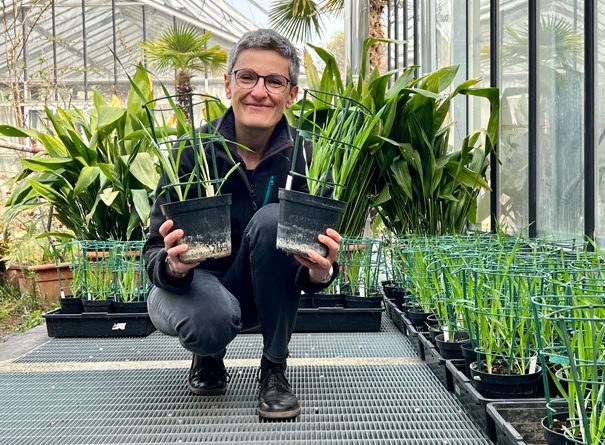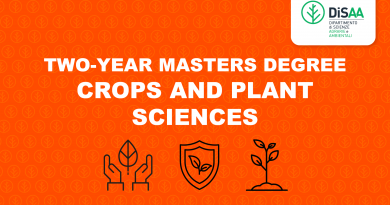#MEETTHEPROFESSORS
In this interview, Laura Rossini, Full Professor in Agricultural Genetics at DiSAA, shares all her passion for research, with a particular focus on plant genetics. The interview takes place at the Città Studi Botanical Garden where many of the university’s research activities on plants are carried out.
In this interview, Laura Rossini, Full Professor in Agricultural Genetics at DiSAA, shares all her passion for research, with a particular focus on plant genetics. The interview takes place at the Città Studi Botanical Garden where many of the university’s research activities on plants are carried out.
So, how did you come to be a teacher in genetics?
My first real passion was biology, so I chose this subject for my degree here at the University of Milan. I remember my family friends being a bit sceptical about my choice; they thought I would be unemployed for the rest of my life.
Well, they clearly changed their minds. How did you like university life?
Oh, since day one, I was super thrilled. I loved the buzz of a big community of students
And genetics?
Later on, in the second year of my degree I had a course about genetics and everything suddenly looked clear to me. My love for plants and plant genetics just blossomed. In particular I remember my Professor, Ercole Ottaviano – he was a brilliant plant geneticist and an excellent teacher and he opened a whole world to me. I therefore decided to challenge myself and ask him to join his lab for my thesis project. I was very excited to start doing research but a bit intimidated in the beginning – it was a very dynamic environment, I recall.
I am sure you managed!
Yes, I did! Attending his classes meant a lot for my career development. It was like an epiphany. I am a big believer that teachers can change their students’ life and therefore, as teachers, we do have a huge responsibility!
I’ve been following your projects and activities for months now and I could see how students hang on your words.
You know, I am really committed but I also had to work on this. When I first started teaching I didn’t enjoy it. I thought it was just a distraction from my research. Then, I engaged in a course in communication, which changed my perspective. Together with a small group of colleagues I spent one week with a communication expert with the purpose of improving my communication skills.
This is very important, even for professors.
Yes! This is of paramount importance. During the course we did some simulated lessons. The teacher filmed us and provided personalized feedback. I remembered being asked to prepare a 10’ introductory speech and I worked hard on it, following some instructions and tips. So I thought, if I am doing this for a course, I should do it even better for my own students. They should get the best from me. This course made me understand that my real strength is my enthusiasm – I started to work on that and found teaching can be as exciting as research!
Tell me more about your work.
It changed a lot through the years. In the beginning, I mostly worked in the lab and the field. Now, I am essentially leading and coordinating various projects running in my research team.
Would you mention one that you are carrying out at the moment?
I think of BARISTA.
Cool name.
The name is the acronym of a very complicated title. Our Finnish partner came up with this idea. In Finland as well as in Italy, BARISTA is the person that makes you coffee.
Is this an international project?
Yes, many researchers from several EU countries -Poland, Denmark, Germany, UK, Finland, Estonia, Spain and Italy- are involved in it. The project is funded under the FACCE JPI SusCrop ERA-NET research scheme.
What’s the purpose of BARISTA?
The overall goal of the project is to develop advanced tools for breeding BARley for Intensive and SusTainable Agriculture under climate change scenarios. In detail, within my team we work on the improvement of barley stem robustness. In fact, due to strong winds or other adverse meteorological conditions, if the stem is not strong enough, plants fall over making harvesting difficult and thus leading to yield losses. This phenomenon is called lodging.
I see. And how can you make the stem stronger?
The barley stem has a hollow structure – a bit like a drinking straw: if we increase its diameter we can make it stronger and therefore more resistant to lodging. Our project aims to make a more sustainable usage of crops.
Can’t farmers use also the grains from lodged plants?
Well, in part they could, but they lack in quality. When plants fall to the ground, they retain humidity which can favour the spread of fungal diseases negatively impacting grain quality. Preventing lodging is very important and it is recognised by farmers as one of the most important aspects to improve in cereal cultivation.
How can you improve the stem size?
It is a combination of approaches. First of all we developed a protocol to section and obtain images from stems and extract some measurements in order to understand how big or small the stems are in different varieties. Then, we match these data with DNA markers to find if any can be associated with stronger stems and resistance to lodging.
Do you also grow barley in the field?
Yes, we run field trials in different locations in order to study plants with different features under real life conditions. For example, crossing progenies we developed in collaboration with the University of Silesia (Poland) are now growing in Germany and Estonia.
Do you also perform experiments in a molecular genetics lab?
Yes. In the lab, we run DNA analyses to identify genetic differences between plants and try to understand if these differences in the DNA explain some differences in the trait of interest.
Why is genetics important?
Mostly for two aspects. First, as scientists we are interested in understanding how the world works. Here in the botanical garden plants surround us and I am very interested in understanding, for example, the reasons why a plant develops a specific architecture.
But why would this be relevant?
Architectural features such as the number and orientation of branches, leaves and flowers have direct implications for plant performance and productivity so knowledge of the genetic control of these traits is key to improve the amount of production from a hectare of land. This is of paramount importance for sustainability. The world’s population is growing and we need to make efficient use of cropland to provide everybody with healthy, nutritious and abundant food.
What does sustainability mean to you?
Sustainability is to find a way of producing enough food, for everyone, balancing that with environmental considerations. Agriculture is one of the most important activities established by humans on the planet. We use a significant percentage of land to farm crops and we should think of what this implies for the environment.
Many reports say that agriculture should be more environmentally friendly. Do you agree?
In other words, this means to go for a type of agriculture that make less use of chemicals and pesticides but also able to produce more from one portion of land. As geneticists we have a central role to play, we can contribute to both aspects: we can build crops that are more resistant to pests and diseases and on the other hand we can make this unit of land more productive to spare other land for wildlife.
Very interesting.
People working in the field of crop genetics are very aware of these sustainability matters and have been working with agronomists, pathologists and scientists involved in agriculture research to improve its sustainability. Therefore, sustainability approaches are improving day by day.
Yes, there is a growing interest towards sustainability worldwide.
Sustainability is a complex topic that involves many disciplines.
We should use every tool we have to tackle this problem. Beyond lifestyle choices such as wasting less food consuming less meat, we should integrate a range of approaches and take into account future scenarios …especially in the African continent, fertility is high and mortality rates decreased so the population is predicted to grow.
Who was the most important geneticist ever to you?
I am a big fan of Mendel. This year it is the bicentenary of his birth. There will be many events to mark this anniversary, including in Milan.
I remember he was the guy making experiments with the garden peas.
He was an incredible figure. Coming from a farming family, to get access to university studies he decided to enter the monastery and become a monk. He studied natural sciences and physics and mathematics. He combined multidisciplinary approaches to study how traits were passed on from one generation to the next and that’s how he came up with his famous theory about inheritance. He had an innovative mind, crossing disciplines and inventing a new way of looking at something extremely important.
That’s why he is so well recognized nowadays.
Well, he wasn’t the best communicator. His work went unnoticed for many years. He discussed his work in a small scientific society in what is now the Czech Republic and not many people read his paper. At the beginning of the 20th century, other scientists independently reached results similar to Mendel’s and realizing that Mendel had preceded them they gave him credit. This is what is called the rediscovery of Mendel’s laws.
What are you organising in Milan for Mendel’s celebrations?
In September 2022, in the 2 main botanical gardens of Milano, in Città Studi and in Brera, we will showcase Mendel’s legacy with conferences, exhibits and workshops open to the public. Not only talking about plant genetics but also genetics of humans and other species.
Tell me a bit more about your own activity.
I work with two other professors with some activities focused on cereals and especially maize, rice and barley. I will present, with the help of my students, the history of barley, a very fascinating cereal domesticated by humans over ten thousand years ago. Vittoria Brambilla is a big expert and fan of rice and also has a fascinating story to tell, as well as Gabriella Consonni for maize.
You are all women…
And I am very proud to be part of this team of scientists. We really enjoy working together. I think that when we will meet the public, we could set an example also for young girls and their families. Women can engage and be successful in science.




